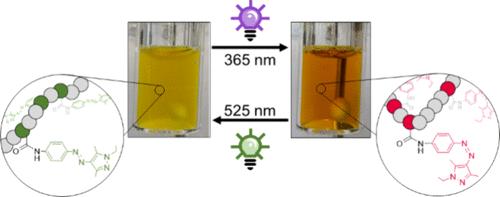通过偶氮唑功能化聚丙烯酰胺制备完全光响应的两亲性聚合物
IF 5.2
1区 化学
Q1 POLYMER SCIENCE
引用次数: 0
摘要
芳唑吡唑(AAPs)是一种新兴的光开关,由于其独特的E-和Z-异构体的吸收最大值,在紫外线或可见光照射下分别具有高度富含Z-或E-异构体的光稳定态,以及亚稳Z态的长寿命而脱颖而出。在这里,我们提出了水溶性丙烯酰胺共聚物功能化的AAP染料。这使得它们既具有热响应性又具有光响应性,并且能够通过E- to - z异构化对水溶液中lcst型相变温度(PTT)进行可逆调制。通过紫外光和绿光的交替照射,PTT可以有效地调制,并且可以为优化的AAP含量移动高达27°C,即比普通偶氮苯光开关高得多。利用密度泛函理论计算、浊度测量和温度相关的核磁共振、EPR和紫外可见光谱研究了AAP光开关和染料改性聚合物的转变过程。本文章由计算机程序翻译,如有差异,请以英文原文为准。

Toward Fully Photoresponsive Amphiphilic Polymers via Azopyrazole-Functionalized Polyacrylamides
Arylazopyrazoles (AAPs) are a rapidly emerging class of photoswitches, which stand out due to their distinct absorption maxima of the E- and Z-isomers, the highly Z- or E-isomer-rich photo stationary states upon irradiation by UV- or visible light, respectively, and the long lifetime of the metastable Z-state. Here, we present water-soluble acrylamide copolymers functionalized by an AAP dye. This renders them both thermo- and photoresponsive and enables the reversible modulation of their LCST-type phase transition temperature (PTT) in aqueous solution by the E- to Z-isomerization. By alternating irradiation with UV and green light, the PTT is modulated effectively and can be shifted for optimized AAP contents by up to 27 °C, i.e., much higher than by common azobenzene photoswitches. The AAP photoswitch and the transition process of the dye-modified polymer are investigated using density functional theory calculations, turbidity measurements, and temperature-dependent NMR, EPR, and UV–vis spectroscopies.
求助全文
通过发布文献求助,成功后即可免费获取论文全文。
去求助
来源期刊

Macromolecules
工程技术-高分子科学
CiteScore
9.30
自引率
16.40%
发文量
942
审稿时长
2 months
期刊介绍:
Macromolecules publishes original, fundamental, and impactful research on all aspects of polymer science. Topics of interest include synthesis (e.g., controlled polymerizations, polymerization catalysis, post polymerization modification, new monomer structures and polymer architectures, and polymerization mechanisms/kinetics analysis); phase behavior, thermodynamics, dynamic, and ordering/disordering phenomena (e.g., self-assembly, gelation, crystallization, solution/melt/solid-state characteristics); structure and properties (e.g., mechanical and rheological properties, surface/interfacial characteristics, electronic and transport properties); new state of the art characterization (e.g., spectroscopy, scattering, microscopy, rheology), simulation (e.g., Monte Carlo, molecular dynamics, multi-scale/coarse-grained modeling), and theoretical methods. Renewable/sustainable polymers, polymer networks, responsive polymers, electro-, magneto- and opto-active macromolecules, inorganic polymers, charge-transporting polymers (ion-containing, semiconducting, and conducting), nanostructured polymers, and polymer composites are also of interest. Typical papers published in Macromolecules showcase important and innovative concepts, experimental methods/observations, and theoretical/computational approaches that demonstrate a fundamental advance in the understanding of polymers.
 求助内容:
求助内容: 应助结果提醒方式:
应助结果提醒方式:


